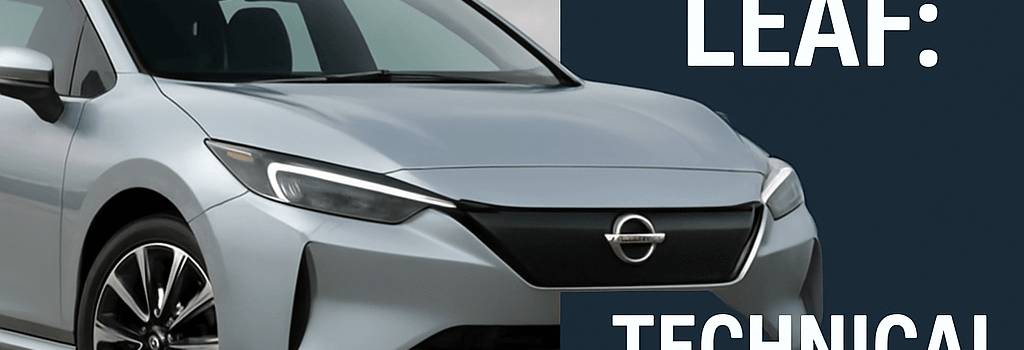2026 Nissan Leaf: Technical Breakdown and Market Overview

Overview and Significance
The third-generation Nissan Leaf debuts in late 2025 as a 2026 model year EV. This ground-up redesign on Nissan s CMF-EV platform represents the brand s most critical mass-market offering since the original Leaf launched in 2010. With rivals such as the Tesla Model 3, Ford Mustang Mach-E, Volkswagen ID.4 and Chevrolet Bolt EV pushing battery, range and charging performance, Nissan must deliver compelling technical upgrades at an accessible price point.
Battery Options and Thermal Management
Nissan offers two lithium-ion battery packs: a 52 kWh base unit and a 75 kWh high-energy pack. Both use a nickel cobalt manganese (NCM 811) chemistry optimized for energy density and cycle life. Key enhancements include:
- Active liquid thermal management using aluminum cold plates and integrated PTC heaters to maintain cell temperature between 15 °C and 40 °C.
- Software-driven preconditioning that warms or cools the battery en route to a DC fast charger, ensuring peak charge rates.
- State-of-charge balancing via dual-core battery management units (BMU) that monitor cell voltages with ±1 mV precision.
These systems address fast-charge degradation concerns and support a consistent 150 kW DC charging rate from 10 % to 80 % SOC in approximately 35 minutes on both pack sizes. The 75 kWh variant delivers up to 303 miles (488 km) EPA range in the S+ trim.
Powertrain Integration and Performance
The new Leaf adopts Nissan s latest 3-in-1 powertrain architecture, combining the electric motor, inverter and reduction gearbox into a single compact housing. Benefits include:
- 10 % reduction in powertrain volume that frees up underfloor space for a lower center of gravity.
- Improved thermal coupling between motor windings and the inverter substrate for higher continuous output.
- Responsive torque delivery with 174 hp (130 kW) and 236 lb-ft (320 Nm) on the 52 kWh pack, or 215 hp (160 kW) and 265 lb-ft (360 Nm) on the 75 kWh pack.
Charging Standards: Native NACS and AC Charging
Nissan transitions from CHAdeMO to the Tesla-originated North American Charging Standard (NACS) for DC fast charging, reflecting industry convergence around Tesla s connector. The Leaf sports two charge inlets:
- Left fender: SAE J-1772 for Level 1/2 AC charging up to 11 kW.
- Right fender: NACS dedicated to DC fast charging up to 150 kW.
The dual-port layout avoids cumbersome adapters, and the infotainment system will display clear prompts if the wrong inlet is used for a given charge type. Plug and Charge support under ISO 15118, alongside Nissan s Connect app, enables automatic billing and simplified station authentication.
Design, Aerodynamics & Interior Packaging
Despite being 3 inches shorter overall and with a 0.4-inch shorter wheelbase than its predecessor, the 2026 Leaf is 0.8 inches wider and retains the same roof height. Key figures:
- Drag coefficient: 0.26 cd vs 0.29 cd previously, thanks to active grille shutters and flush underbody panels.
- Rear legroom: +8.7 inches (221 mm) due to thinner seat backs and optimized floor architecture.
- Cargo volume: 20 cu ft (566 L) upright, expanding to 55.5 cu ft (1,572 L) with rear seats folded and the Divide-n-Hide false-floor divider removed.
Infotainment, Connectivity & OTA Updates
The S+ trim and above feature a Google-based infotainment system with native Maps, navigation and charger awareness. Standard on every model is wireless Apple CarPlay and Android Auto. Additional highlights:
- Over-the-air software updates for vehicle systems, including battery management tuning and ProPilot Assist improvements.
- Charging diagnostics that display real-time DC charge power and predicted peak rates, similar to Mercedes-EQ energy analytics.
- Integrated telematics via the Nissan Connect app for remote preconditioning, charge scheduling and route planning with charge stops.
Advanced Driver Assistance Systems
All trims include Nissan s ProPilot Assist (SAE Level 2) with lane centering, adaptive cruise control and traffic-jam assist. However, the Leaf does not offer the newer ProPilot 2.0 hands-free highway driving currently available on the Ariya. Regenerative braking is managed via a standard e-Step toggle, but one-pedal drive mode is omitted to simplify the transition for drivers new to EVs.
Battery Supply Chain and Sustainability
Nissan sources its battery cells from Envision AESC s plant in Japan, leveraging cylindrical and prismatic modules with >600 Wh/L energy density. The company has committed to a closed-loop recycling program with partner Redwood Materials to reclaim critical metals and reduce lifecycle carbon emissions by up to 40 %
Market Outlook & Pricing Strategy
Analyst firms forecast 2026 Leaf deliveries of 80,000 units in North America, provided the starting price remains near $30,000 before incentives. A base S trim with the 52 kWh battery is expected to undercut the Chevrolet Equinox EV entry level, while the S+ should compete directly with the Volkswagen ID.4 Pro.
According to EV market analyst Sarah Liu, Nissan must maintain aggressive pricing or risk ceding volume to lower-cost imports and domestic brand offerings.
Future Software Roadmap & OTA Enhancements
Looking beyond launch, Nissan plans iterative OTA releases to enable:
- Refined battery thermal curves for broader temperature operating windows.
- Enhanced ProPilot features, potentially adding hands-off driving on mapped highways.
- Wireless vehicle-to-grid (V2G) and bidirectional charging capabilities for home backup power.
Conclusion
The 2026 Nissan Leaf blends compact EV efficiency with industry-leading thermal management, NACS fast-charging integration and an agile software ecosystem. Its success will hinge on pricing, supply chain stability and the effectiveness of Nissan s ongoing OTA support to keep pace with ever-evolving EV technology.